Travel in India
NANDANKANAN: The Celestial Garden for Wildlife

Everybody contemplates as human beings are the best creations by the almighty. But besides them, it is the varied wildlife creatures and their panoramic views across the length and breadth of the world are definitely going to sooth and sensitize the sightseers. The Nandankanan, literally meaning The Garden of Heaven near the outskirt of Bhubaneswar, capital of Odisha in the environs of the Chandaka forest, and includes the 134-acre (54 ha) Kanjia lake brings godly pleasure to its viewers. Established in 1960, it was opened to the public in 1979 and became the first zoo in India to join the World Association of Zoos and Aquariums (WAZA) in 2009. It also contains a botanical garden and part of it has been declared a sanctuary. A major upgrade was done in 2000 (after the damage caused by the super-cyclone of 1999 in coastal Odisha). More than 3.3 million visitors visit Nandankanan every year
History
Forest officials decided in 1960 that including rare plants and animals in the Odisha pavilion at the World Agricultural Fair in Delhi would help increase attendance. The message was sent to the forest department to capture as many small animals as possible for the display. In all, the forest department managed to capture two spotted deer (Axis axis), two barking deer (Muntiacus muntjak), two blackbuck (Antilope cervicapra), one mouse deer, one leopard cat, one flying squirrel, one racket-tailed drongo, one hornbill, two parrots, two hill mynah, one peacock, and a mongoose. In addition, the divisional forest officer of Deogarh captured a pangolin (scaly ant-eater) and two porcupines, and the divisional forest officer of Puri captured a pair of wild boars and a Python. All of these animals were delivered to the Delhi fair and exhibited at the Odisha pavilion.
The State Finance Department raised objections to a zoo in Odisha because of the cost of both establishing and maintaining the facility. While the issue was being debated, animals arrived back at Bhubaneswar in May 1960, posing problems to the forest department for housing and feeding them. P. Mohandra (Divisional Forest Officer, Puri) and G. K. Das (Divisional Forest Officer, Deogarh) built temporary structures at Khandagiri for the animals, and the community of Jain helped feed them. Discussions about a real zoo started soon after Dr. H. K. Mahatab, then Chief Minister of Odisha visited the animals.
The initial proposal placed the zoo at Ghatikia close to Khandagiri and Udayagiri caves. However, this was deemed to pose water problems in the future. A zoo needs a lot of water to meet the need of animals, cleaning of animals sheds and for various other purposes. The then Range Officer, Chandaka suggested Jujhagarh forest block on Kanjia lake near Barang Railway station as the most ideal location. The then Chief Conservator of Forests, Divisional Forest Officer, Puri, Range Officer, Chandaka and D.P. Ghosh, Forest Ranger visited the place and were impressed with its scenic beauty. Kanjia lake with its vast expanse over 125 acres low and undulating hills of Jujhagarh and Krushnanagar with lush green vegetation on both sides of the lake presented a picturesque site. Jujhagarh Forest Block had all the advantages for locating the zoo except communication from Bhubaneswar and the only approach was via Chandaka covering a distance of 38 km.
A committee consisting of Dr. Radhanath Rath, Sri G.C. Dash, and Sri D.N. Choudhury, the then Minister of Forests, Secretary, Forest and the Chief Conservator of Forests respectively visited the place. They were very much impressed with its aesthetic beauty and recommended the location of the zoo there with construction of a straight road (a distance of 14 to 15 km) from Bhubaneswar.
Accordingly, it was decided to locate the Zoological Park in Jujhagarh Forest Block, Botanical garden in Krushnanagar Forest Block and develop Kanjia lake for Boating and Angling. The Director, Fisheries agreed to develop a portion of the lake for rearing various kinds of fish for visitors to see. Initially, it was decided to keep spotted deer, barking deer, black bucks, wild boars, sambars, nilgai, and bears in spacious enclosures. Other animals like the leopard cat, mongoose, flying squirrel, porcupine, python, monkeys, hyena, jackal, civet cat, pangolin, jungle cat, parrots, mynah and other birds in suitable cages. It was decided to put efforts to capture tigers and leopards which could be exhibited in suitable cages for the time being and the suitable spacious enclosures would be built for them later on. It was also decided to raise a good flower garden and to plant important species and medicinal plants of Odisha inside proposed Botanical garden in Krushnanagar. Eventually, the site around the 134-acre (54 ha) Kanjia Lake was chosen. The lake would be developed for recreation as well. A 15-kilometer (9.3 mi) road was built to the site, and Nandankanan Biological Park was officially inaugurated on 29 December 1960, by Sri S. K. Patil, then Indian Minister of Food and Agriculture.
A botanical garden was opened in 1963. The first tiger arrived at the zoo in 1964 from the Alipore Zoo in Calcutta, along with a pair of African lions, a pair of Mugger crocodiles, and a puma. The facility was renamed Nandankanan Zoological Park in 1981.
In 2009 Nandankanan Zoological Park became the first zoo in India to be registered member of the World Association of Zoos and Aquariums (WAZA)
Special Attractions –
The sylvan setup of the Park provides many special features which attract the visitors in large numbers.
Boating
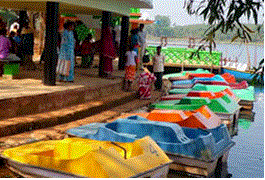
Boating on the paddle or rowboats in the blue water of Kanjia lake is an exhilarating experience. The multi-storey Boat Ghat is renovated to give new looks providing enough space for the visitors to relax and enjoy the picturesque freshwater spreading over an area of more than 66 ha. lake. The boating service is outsourced for better management and satisfaction of the visitors. The lake is also known for its rich floral and faunal diversity and is declared as a Wetland of National Importance by Govt. of India.
White Tiger Safari

A unique white tiger safari established on 1st October 1991 over an area of 12 ha in natural surroundings. It provides exposes you to a unique situation where the visitors are confined in a vehicle and the animals roam in the open jungle. Nandankanan is the first zoo in India with a white tiger safari.
Lion Safari

A twenty-minute drive through the meandering roads crisscrossing the natural forest in a specially protected vehicle takes the visitors straight into a pride of lions in the lion safari over an area of 20 ha established in the year 1984.
Herbivore Safari

Herbivore safari was established in the year 2011 extending over an area of 21 ha. with a road network of 2 Km. length. The safari houses Barking Deer, Spotted Deer, Sambars, Four-horned antelope, wild boar, jungle fowls, peafowls, etc.
Bear Safari


A Bear safari covering an area over 5 ha. has been established in the zoo during the year 2012. Visitors can avail the opportunity to sight sloth bears in their natural habitat through safari bus service.
Reptile Park
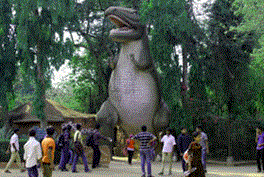
A reptile park, with a life-size Tyrannosaurus at its entrance with an interpretation center, houses 27 species of reptiles including crocodiles, lizards, turtles, and snakes. One would encounter crocodiles, king cobras and a huge Reticulated Python inside the reptile park.
Amphibian Enclosure

An amphibian enclosure has been established with viewers’ gallery over a plinth area of 56 m2. Necessary behavioral enrichments like flowing water saw dust, live plants, water pool, etc. have been provided within the enclosure. The enclosure is designed to house and display amphibian species. Nandankanan is the first premier large zoo to exhibit amphibians. At present, there are 21 numbers of amphibians belonging to six species.
Open Top Leopard Enclosure

The new open-top Leopard enclosure in Nandankanan is one among the very few in the country which attempts to exhibit this species in a large naturalistic enclosure which is open to the sky. This enclosure has been designed aesthetically to maximize visitor satisfaction without compromising the safety and security of the animal as well as visitors. The enclosure which has an exhibit area with a deep dry moat also has four feeding chambers and two back kraals. The entire enclosure has existing natural vegetation including two large Ficus bengalensis trees together with other trees and bushes. In addition, environmental enrichment by way of machan platforms, stone cave, wooden logs, water trough, etc. has been provided to encourage them to indulge in natural activities.
Toy Train
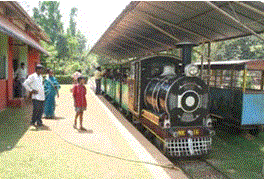
The toy train has been a great attraction for the children. Its starts from the toy train station which goes around a circular track of 1.58 Km. along the lake and thickly vegetated hillock area with free-ranging herbivores. The entire facility is now under renovation.
Aquarium

The aquarium is an integral component of a modern zoo. Adequate steps were taken to include well-researched education materials on the various aquatic ecosystems both marine and freshwater indicating their uniqueness and conservation needs. The aquarium was dedicated to the visitors on 4th February 2008 by the Honourable Chief Minister, Odisha.
Battery Operated Vehicle

To facilitate elderly and physically challenged visitors in particular and tourists in general, Battery Operated Vehicles (BOVs) are available for tourists for an hourly trip around the zoo on payment of Rs.50/- per head and Rs 750/-and Rs 500/-per trip of large and small BOVs respectively.
Library

If one has got the time and an aptitude for learning then the centrally located library, with a wonderful collection of more than 3000 books and journals on wildlife, veterinary and other matters can serve one’s satisfaction.
Nocturnal Animal House

Many animals that only move freely at night but are almost immobile and hide in the thicket or in their burrows during the day are housed here. The twilight condition is created in these enclosures to provide an opportunity for the visitors to know what these animals secretively do in the darkness of the night.
Reptile Interpretation Centre

An Interpretation Centre depicting the evolution and biology of reptiles has been established in the entrance of Reptile Park displaying models of prehistoric animals.
Interpretation Centre

The Interpretation Centre has been established near the entrance gate. The Centre has display boards, models and audiovisual aids depicting the importance of Zoological Park and other important wildlife areas of Odisha. It also displays the activities behind the scenes for creating awareness amongst the visitors. A film on Nandankanan is also screened in the mini-auditorium inside the Centre.
Zoo-Museum

The zoo museum established in Nandankanan to preserve, display and interpret the animal specimens of zoological importance for public viewing and nature education. The museum displays taxidermy specimens, formalin preserved specimens of early developmental stages of animals and eggs of flightless birds. This facility will be of great interest to the visitors in general and school children in particular.
Electronic Gate Entrance System
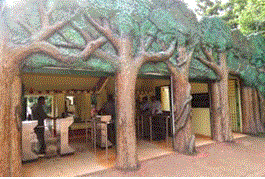
An automated electronic entry gate system has been installed in the Zoological Park on 30.03.2012. Each visitor is issued with a bar-coded ticket for entering through any of the six electronic gates into the park. This gives an exact figure of adult, children and foreigner visitor entry statistics at any point in time. This facility is the first of its kind for entry into any tourist place in Odisha.
Walkthrough Aviary

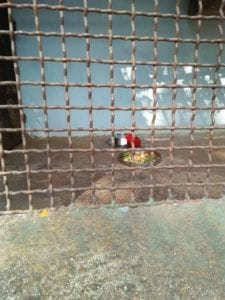


The walk-through aviary for exotic birds is a unique exhibit of its kind in the country. The walkthrough aviary has a cascading waterfall and a meandering water channel of 58 m length connecting two pools having two arched crosses over the bridge along the 216 m laterite stone paved the walking path with separate entry and exit points. In addition to the existing large and small trees, hundreds of selective plants have been planted to provide perches and hiding places for the birds housed. There are enough feeding points and nest boxes for use of the birds selectively. The inmates of the aviary are mixture of arboreal, terrestrial and aquatic birds. It is a visitor’s delight to view the free-flying birds overhead.
The Safari Sojourn

The major attraction for the tourists is the beautiful and bucolic safaris consist of sloth bears, deers, tigers, and lucrative lions. The specially protected bus will board the tourists for an enthralling, exciting and apprehending journey starting with deer safari and concluding at lion safari. Visitors throughout their journey not only bemused by the panoramic beauty of wildlife animals but by their out of the ordinary cameos. In this context, it reminds me of an incident from my last visit. A sloth bear sobriquet as “Diesel “ blocked our road as the bus entered to their den. According to sources it loves the odor of diesel running vehicles. As soon as the buses cross their safari, it comes out of its habitat to take a glimpse of its fans. Besides the bear safari, the hopping peacocks and perky and piquant deers at a striking distance have always attracted the attention of tourists.
The steeled gates of entries and exits create apprehension and excitation among the visitors during our en route to the much-awaited abode of tiger and lion safari. No doubt their gifted morphs are soothing to the eyes but it certainly raises few questions in the minds, do the deadly animals have lost their aggression for some reasons or other?
Nandankanan zoological park was declared as the wildlife sanctuary on 3rd August 1979. It is certainly a place to travel during your leisure’s and vacations. Apart from children, ages of all persons have something to watch and mull over during their visit to the celestial garden. The scintillating and satiating picturesque scenic views of wildlife’s, diversified botanical species and avifauna of wetland alleviates the common man’s pain and provides them something to ponder for the rest of the life.





























